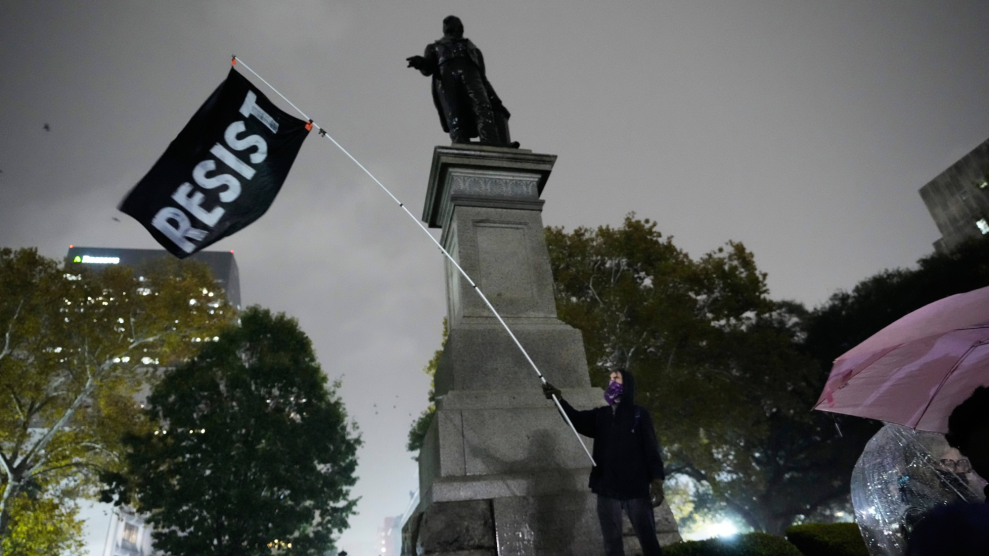Image: Sonia Ulan Hohol
In his 50-odd years of farming, Percy Schmeiser has seen his share of combat. He’s battled floods, drought, disease, crop-devouring insects, and a market that’s forever in flux. But today, at 69, this feisty third-generation farmer who raises canola (or rapeseed) near Bruno, Saskatchewan, finds himself in the fight of his life. Schmeiser is taking on one of the world’s largest agrochemical companies: Monsanto.
In Canada, where more than 20,000 of the 35,000 to 45,000 canola farmers are planting Monsanto’s patented Roundup Ready canola seeds, Schmeiser is part of a growing minority. Although he is not an organic farmer, he had always planted canola the old-fashioned way, saving his best seeds from each crop and using them in subsequent seasons, occasionally going to market to buy new seeds to add to the mix. Farmers have used this method for thousands of years.
For Schmeiser, seed saving was a way of life. “I’ve developed my own seed over many years of trial and error because I’ve grown it consecutively for almost 50 years,” he says. “I had a really good variety that was resistant to a lot of different diseases that were prevalent here in canola fields.”
But in the age of genetic engineering, this tradition now holds the potential to turn farmers like Schmeiser into unwitting criminals. And indeed, Monsanto’s case against Schmeiser shows that the law may not be on the farmer’s side.
Schmeiser’s Story
The imbroglio with Monsanto began in 1997, when Schmeiser says an uninvited guest showed up on his farm. After spraying Monsanto’s Roundup to clear out weeds from roadside ditches and around telephone poles — something he had done prior to planting for some 15 years — Schmeiser says he was shocked to see that a number of stray canola plants didn’t die.
Curious to see how far these sturdy plants went into his property, Schmeiser sprayed a small “test strip” along the side of the road. The plants had spread into his fields, thinning as they got further from the road — a pattern consistent with what happens when seeds blow off a truck.
Though Schmeiser says he thought it was strange that the canola plants could survive applications of Roundup, it never occurred to him that they might have grown from Monsanto’s patented Roundup Ready canola seeds; indeed, he claims, he didn’t even know such seeds existed. So Schmeiser took seeds from these hearty roadside canola plants and planted them, along with his usual seeds, on 900 to 1,000 acres in the 1998 season.
During that season, Schmeiser sensed something was wrong. “I noticed that my yield in 1998 was much lower than normal,” he said in an affidavit, “which I now attribute to the contamination of my fields by this genetically modified plant.”
Monsanto sued Schmeiser in 1998. The company claimed to have evidence that Schmeiser had illegally obtained, planted, and profited from its patented Roundup Ready canola seeds.
The company wanted Schmeiser to pay back the money he had made from the allegedly stolen seeds. Schmeiser refused, saying that Monsanto’s canola seeds ended up on his farm by accident and therefore he didn’t owe anything. Schmeiser has argued that Monsanto’s seeds could have fallen onto his property from trucks that pass along the road that borders his farm, or that his crop was pollinated by a neighboring field containing Roundup Ready canola.
In Schmeiser’s sworn affidavit, he says he didn’t even want Monsanto’s plants on his land. “I have no interest or desire in growing [Monsanto’s] genetically modified canola. Over the years I had developed my own superior yielding canola seed which is now ruined because of the infiltration by Monsanto’s genetically modified canola.”
Schmeiser says he had to destroy his seeds, which have taken years to develop, to insure his future crops would be free from contamination. He says that 20 percent of his 2000 crop is nonetheless genetically modified, despite his efforts.
Monsanto didn’t buy Schmeiser’s story, and sought about US$300,000 in damages. A three-week trial took place in June of this year and the judge has yet to return a verdict.
Schmeiser is now a hero among small farmers and anti-GMO organizers around the world for taking on biotech agribusiness, their common enemy. He has filed a $10 million countersuit against Monsanto claiming the company defamed him and trespassed on his land, and that its seeds damaged the ecological balance of his farm.
“I got thrown into something that I never ever wanted to be in. I’d rather be fishing with my grandkids. But, now that I’m in it, I don’t regret the decision,” says Schmeiser. “I don’t want to be a hero or a saint but, by God, there comes a time when you’ve got to take a stand.”
Monsanto’s Side Monsanto representatives have acknowledged that they have launched somewhere between 100 and 525 technology infringement cases against farmers in the United States and Canada. Most have been settled out of court. Only Schmeiser’s has reached trial.
The company is willing to risk negative publicity by going after small farmers like Schmeiser because it spends hundreds of millions of dollars developing each high-tech seed product it brings to market. Its line of patented seeds — more than 10 different types of canola are currently available — are genetically engineered to have certain qualities such as the ability to survive applications of Monsanto’s weed-killer Roundup. To ensure it gets a return on its investment the company charges steep prices and insists farmers sign “technology use agreements” before they can plant seeds. The contract states that farmers must buy new seeds from Monsanto for each growing season and allows the company to take samples of their plants for three years following each purchase.
Monsanto admittedly uses aggressive methods to root out those who buy its seeds on the black market or save seeds from one growing season and use them in the next — a practice known as “brown bagging.” The company hires private investigators (it calls them “auditors”) to dig up evidence on growers it suspects of foul play. It has broadcast the names of violators in radio ads. Monsanto even ran a toll-free telephone line where growers were encouraged to call in and snitch on neighbors.
But, for the most part, growers seem willing to put up with Monsanto’s enforcement practices. “[Schmeiser is] the exception as opposed to the rule here,” says Craig Evans, general manager of biotech at Monsanto Canada. “Most people see the value of the technology. If they didn’t see value they wouldn’t buy it.”
And plenty of farmers are buying Monsanto’s seeds along with the herbicides and pesticides it bundles with them. Monsanto cleared $1.2 billion from seed sales in the first nine months of 2000. The company estimates that its genetically engineered seeds were used on nearly 94 million acres worldwide during the 2000 crop season, an increase of 9 percent from 86 million in 1999. Not bad, given the first genetically engineered seeds came on the market less than 10 years ago.
And it’s not just Monsanto that’s getting bumper returns: There are more than 50 companies developing genetically engineered seeds.
While Schmeiser is often cast as David to Monsanto’s Goliath, his innocence is anything but obvious. With its seeds verily taking over the canola market, Monsanto finds it unfathomable that Schmeiser could have not known about their existence. When the company first introduced its canola seeds in Canada in 1996, the company says it held informational meeting in Schmeiser’s area and placed ads in the local papers. “What kind of excuse is ‘I didn’t know it was there’?” says Evans. “He’s not uneducated. He’s not uninformed.”
Monsanto also has a difficult time believing that Schmeiser didn’t knowingly plant their seeds. “We’d had some reports from other farmers that Mr. Schmeiser was growing Roundup Ready canola without a license on his farm,” says Evans. Acting on these tips, Monsanto then hired private investigators to gather evidence on Schmeiser. At Humboldt Flour Mill, where Schmeiser gets his seeds treated, one investigator obtained samples of Schmeiser’s seeds. The investigators also snipped samples of Schmeiser’s canola for DNA testing. (Schmeiser’s suit claims they trespassed; the company says they took samples from public land adjacent to Schmeiser’s farm.)
After gathering evidence, the company launched its civil suit against Schmeiser and then obtained a court order that would allow them to take samples from the entire 900 acres for testing purposes. “What the samples showed was that well over 90 percent of his crop was Roundup Ready,” says Evans.
Monsanto disputes Schmeiser’s claims about seeds falling off a passing truck and cross-pollination. The company argues that none of its trucks carrying the seeds passed by Schmeiser’s farm in 1996. At least one scientist also testified at the trial that while cross-pollination is possible, it couldn’t have occurred at the level found on Schmeiser’s farm.
Monsanto insists that it doesn’t go after farmers who end up with GMO canola because of unintended cross-pollination. “We didn’t introduce the technology so we could go out and trick farmers and catch them and sue them for patent infringement,” says Evans. “What our concern is that if we have someone who purposefully plants the seed to create a competitive advantage.”
The real challenge for Monsanto is proving that Schmeiser intentionally replanted Monsanto seeds. Although Monsanto claims in an affadavit that Schmeiser illegally “obtained” the seeds, Evans told the MoJo Wire, “We have no definitive evidence in terms of where he got the seed.”
Still, Monsanto wonders why Schmeiser didn’t do something about the mysterious plants that appeared on his land. “It was on his farm, he didn’t want it, he called it a contaminant that was polluting his fields,” says Evans. “But not once did he call Monsanto, nor did he call his ag rep to come out and look at it and settle the problem.”
In many ways, the law is on Monsanto’s side in this case. Under patent law, it doesn’t really matter whether Schmeiser knew what he was doing or not, he’s still an “infringer,” says Dan Burk, a professor at the University of Minnesota Law School who specializes in biotechnology and intellectual property law.
Burk says Monsanto has little choice but to go after farmers like Schmeiser. “Legally, if you have a patent you have to continually police it and enforce it or you lose it,” says Burk. “If I know you’re infringing on my patent, and I let you do it for long enough, and then I go to court and try and stop you, the court’s going to say, ‘Hey, why didn’t you … do this sooner?'”
But what happens when a company’s technology infringes on a grower’s property, especially when he doesn’t want it anywhere near his crops? There is no way to fully contain seeds and pollen once they’re in the environment.
Case in point: the recent Starlink debacle. Aventis Corporation’s genetically engineered Starlink corn is approved only for animal feed but made its way into food products, some say because of cross-pollination. The result was a massive recall and federal investigation.
In the organic food industry, where products have to be certified GMO-free, contamination has now become a major issue. With millions of acres of genetically engineered seeds already being grown in all the major farming regions in North America, many organic farmers are taking steps to protect themselves.
“Many organic farmers have just stopped growing canola,” says Marina Buchan of the Peace River Organic Producers Association in Alberta, Canada. “They say it’s not worth it, it’s too risky. It’s affecting growers’ livelihoods.”
















